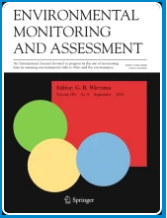Publications

|
Vinay Kumar Dadhwal Spatiotemporal atmospheric in-situ carbon dioxide data over the Indian sites-data perspective https://www.nature.com/articles/s41597-024-03243-x Co-Authored with Mahesh Pathakoti, Mahalakshmi D.V and et.al. Scientific Data, 11(1), 385 |

|
Anindya Sinha Twinning in wild, endangered lion-tailed macaques Macaca silenus in the Anamalai Hills of the Western Ghats, India https://link.springer.com/article/10.1007/s10329-024-01129-5 Co-Authored with Ashni Kumar Dhawale. Primates (2024) Many primate species show various behavioural and ecological adaptations to provisioning, one of which is the unusual occurrence of twins. Here, we report observations on two pairs of twins in the Puthuthottam population of lion-tailed macaques Macaca silenus in the Anamalai Hills of the Western Ghats and show that some lion-tailed macaque twins can survive under free-ranging conditions if they receive adequate care from their biological mother or another female. More importantly, these findings provide further evidence of increased rates of twinning as a consequence of dietary changes in synanthropic nonhuman primate populations. |

|
Vinay Kumar Dadhwal How natural are the forests in Rajiv Gandhi (Nagarhole) Tiger Reserve? A multi-source data approach https://link.springer.com/article/10.1007/s10661-024-12586-2 Co-Authored with B. Swarada and S. V. Pasha. Environmental Monitoring and Assessment 196:444 This study aimed to monitor long-term land use dynamics for understanding the natural forest integrity and intactness of the Rajiv Gandhi (Nagarhole) Tiger Reserve (RTR) pre- and post-declarations as TR. We employed multi-source data from Survey of India Toposheets (1:50 k), Landsat-7, and Sentinel-2A along with Global Ecosystem Dynamics Investigation (GEDI) vegetation canopy height (10 m) data, a high-spatial resolution CORONA (1970) images and temporal Google Earth Pro images for mapping and validation. To map vegetation type, land use and land cover (LULC) transitions, and fragmentation (1980–2022) we employed a hybrid classification approach. This study also analyzed decadal forest dynamics within TRs using India’s State of Forest Reports (ISFR). Findings reveal significant forest fragmentation and habitat loss due to anthropogenic activities in the TR. Mono-plantations (teak and eucalyptus) were found inside TR, while the buffer (1 km) was occupied mainly with coffee and orange plantations which indicates the prevalence of human footprint. The overall accuracy of the current period (2022) is 92.0% with a kappa coefficient value of 0.90. These plantations were established during the British colonial period (early 1900s) for commercial purposes by clearing natural forests. The present study highlights that mono-plantations have not transitioned into natural forests even after a century. This lack of transformation could potentially compromise the integrity of the native forest. Despite its ecological significance, RTR has experienced disturbance due to human footprint. Hence, there is a need for an action plan to protect this vital landscape by replacing mono-plantations with suitable species to preserve the integrity of the forest. These issues extend beyond the protected areas, impacting surrounding regions and require regular monitoring. The proposed methods can be applied to other protected areas facing similar problems in the country and world. |

|
Gufran Beig Triple dip La-Nina, unorthodox circulation and unusual spin in air quality of India https://www.sciencedirect.com/science/article/abs/pii/S0048969724011021?via%3Dihub= Co-Authored with V. Anand, N. Korhale, S.B. Sobhana, K.M. Harshitha & R.H. Kripalani. Science of The Total Environment, Vol.920:170963, 2024. |

|
Vinay Kumar Dadhwal LiDAR-based reference aboveground biomass maps for tropical forests of South Asia and Central Africa https://www.nature.com/articles/s41597-024-03162-x Co-Authored with Suraj Reddy Rodda, Rakesh Fararoda and et.al. Scientific Data11,334 |

|
Anindya Sinha Engendered Primatology: of Female Primates and Feminist Primatologists https://www.aup.nl/en/book/9789048565290/gender-and-animals-in-history Co-Authored with Sayan Banerjee. In: Gender and Animals in History, Yearbook of Women's History 42, Guest Editor: Sandra Swart, Amsterdam University Press, Amsterdam, 2024, Pages: 137–156. In this chapter, we reflect on our readings of female / feminist primatologists’ studies of female primates and our understandings of the gendered lives of bonnet macaques, a female-bonded nonhuman primate species, endemic to peninsular India. These two focal points provide us with insights into the complexities of individual identity in nonhuman societies and the situatedness of human and other-than- human gender identities in their lived worlds. |

|
G Parthasarathy Padma Shri Award to Dr. Shailesh Nayak https://pubs.geoscienceworld.org/jour-geosocindia/article/100/4/601/636472/Padma-Shri-Award-to-Dr-Shailesh-Nayak Co-Authored with R. Srinivasan. Journal of the Geological Society of India 100(4) : 601-602 Invited News item by Geological Society of India |

|
C P Rajendran The Rumbling Earth: The Story of Indian Earthquakes https://www.penguin.co.in/book/the-rumbling-earth/ Co-authored with Kusala Rajendran. Vintage .ISBN: 9780670095612 The renowned seismologists C.P. Rajendran and Kusala Rajendran offer a riveting story of the Indian earthquakes, their science, history and impact. Like all other natural phenomena, earthquakes are part of life-sustaining forces-- the creators of the mountains, valleys and springs or even deserts on Earth-- a theatre where the show never ends. The book takes the readers to some exciting parts of India to show how earthquakes change the topography where a sea existed not far in the past-- now a salt marsh, affecting the social life, trade and livelihood. The book discusses the likelihood of the next big earthquake in the Himalayas against the backdrop of the devastating earlier ones revealed by archaeology, history and geology. It probes the causes and aftermath of the devastating Indian Ocean tsunami of 2004 and gives a glimpse of the past. The high-impact earthquakes will happen, but they need not always end up as human catastrophes. The authors have spent much of their professional lives studying the earthquakes in India and abroad. They tell us from their vast experience how to negotiate the impacts of earthquakes and related hazards by following science-based strategies. |
